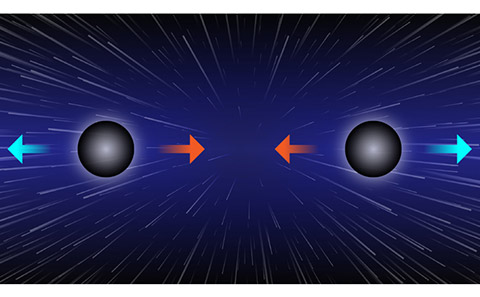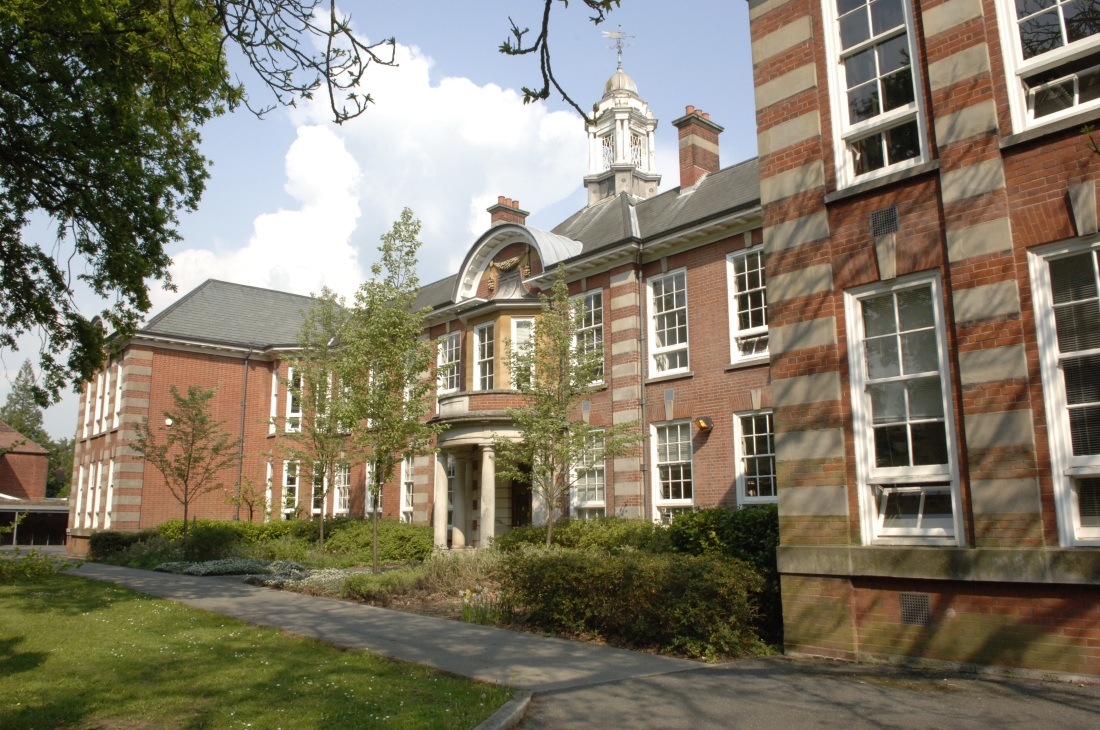From The University of Southampton (UK)
10.19.23

Artist concept of supermassive black hole. Credit: NASA/JPL-Caltech.
Researchers from the University of Southampton, together with colleagues from the universities of Cambridge and Barcelona, have shown it’s theoretically possible for black holes to exist in perfectly balanced pairs – held in equilibrium by a cosmological force – mimicking a single black hole.
Black holes are massive astronomical objects that have such a strong gravitational pull that nothing, not even light, can escape. They are incredibly dense. A black hole could pack the mass of the Earth into a space the size of a pea.
Conventional theories about black holes, based on Albert Einstein’s Theory of General Relativity, typically explain how static or spinning black holes can exist on their own, isolated in space. Black holes in pairs would eventually be thwarted by gravity attracting and colliding them together.
However, this is true if one assumes the Universe is standing still. But what about one which is constantly moving? Could pairs of black holes exist in harmony in an ever expanding Universe, perhaps masquerading as one?
“The standard model of cosmology assumes that the Big Bang brought the Universe into existence and that, approximately 9.8 billion years ago, it became dominated by a mysterious force, coined ‘dark energy’, which accelerates the Universe at a constant rate,” says Professor Oscar Dias of the University of Southampton.

Scientists refer to this mysterious force as a ‘cosmological constant’. In a Universe explained by Einstein’s theory with a cosmological constant, black holes are immersed in a cosmological accelerated background. This moves the theoretical goal posts over how black holes can interact and exist together.

Two black holes at fixed distance. Credit: Alan Stonebraker/APS.
Through complex numerical methods, the team behind this latest study show that two static (non-spinning) black holes can exist in equilibrium – their gravitational attraction offset by the expansion associated with a cosmological constant. Even in the acceleration of an ever expanding Universe, the black holes remain locked at a fixed distance from one another. As hard as expansion may try to pull them apart, the gravitational attraction compensates.
“Viewed from a distance, a pair of black holes whose attraction is offset by cosmic expansion would look like a single black hole. It might be hard to detect whether it is a single black hole or a pair of them,” comments Professor Dias.
Professor Jorge Santos of the University of Cambridge adds: “Our theory is proven for a pair of static black holes, but we believe it could be applied to spinning ones too. Also, it seems plausible that our solution could hold true for three or even four black holes, opening up a whole range of possibilities.”
This study was conducted by Professor Oscar Dias (University of Southampton), Professor Gary Gibbons (University of Cambridge), Professor Jorge Santos (University of Cambridge) and Dr Benson Way (University of Barcelona). Their paper ‘Static Black Binaries in de Sitter Space’ is published in the journal Physical Review Letters [below] and reviewed as a “Viewpoint” in Physics [below] article.

A simple model of a pair of black holes in the presence of a cosmological constant. At a particular separation, the gravitational attraction is balanced by the cosmic expansion. This point is unstable, meaning any tiny fluctuation will lead to collapse or divergence. Credit: Alan Stonebraker/APS.
Physical Review Letters
Physics
See the full article here .
Comments are invited and will be appreciated, especially if the reader finds any errors which I can correct. Use “Reply” at the bottom of the post.
five-ways-keep-your-child-safe-school-shootings
Please help promote STEM in your local schools.
The University of Southampton (UK) is a world-class university built on the quality and diversity of our community. Our staff place a high value on excellence and creativity, supporting independence of thought, and the freedom to challenge existing knowledge and beliefs through critical research and scholarship. Through our education and research, we transform people’s lives and change the world for the better.
Vision 2020 is the basis of our strategy.
Since publication of the previous University Strategy in 2010 we have achieved much of what we set out to do against a backdrop of a major economic downturn and radical change in higher education in the UK.
Vision 2020 builds on these foundations, describing our future ambition and priorities. It presents a vision of the University as a confident, growing, outwardly-focused institution that has global impact. It describes a connected institution equally committed to education and research, providing a distinctive educational experience for its students, and confident in its place as a leading international research university, achieving world-wide impact.
The university has seven campuses. The main campus is located in the Highfield area of Southampton and is supplemented by four other campuses within the city: Avenue Campus housing the School of Humanities, the National Oceanography Centre housing courses in Ocean and Earth Sciences, Southampton General Hospital offering courses in Medicine and Health Sciences, and Boldrewood Campus housing an engineering and maritime technology campus and Lloyd’s Register. In addition, the university operates a School of Art based in nearby Winchester and an international branch in Malaysia offering courses in Engineering. Each campus is equipped with its own library facilities.
The University of Southampton currently has 14,705 undergraduate and 7,960 postgraduate students, making it the largest university by higher education students in the South East region. The University of Southampton Students’ Union, provides support, representation and social activities for the students ranging from involvement in the Union’s four media outlets, to any of the 200 affiliated societies and 80 sports. The university owns and operates a sports ground for use by students and also operates a sports centre on the main campus.
The University of Southampton has its origin as the Hartley Institution which was formed in 1862 from a benefaction by Henry Robinson Hartley (1777–1850). Hartley had inherited a fortune from two generations of successful wine merchants. At his death in 1850, he left a bequest of £103,000 to the Southampton Corporation for the study and advancement of the sciences in his property on Southampton’s High Street, in the city centre.
Hartley was an eccentric straggler, who had little liking of the new age docks and railways in Southampton. He did not desire to create a college for many (as formed at similar time in other English industrial towns and commercial ports) but a cultural centre for Southampton’s intellectual elite. After lengthy legal challenges to the Bequest, and a public debate as to how best interpret the language of his Will, the Southampton Corporation choose to create the Institute (rather than a more widely accessible college, that some public figures had lobbied for).
On 15 October 1862, the Hartley Institute was opened by the Prime Minister Lord Palmerston in a major civic occasion which exceeded in splendor anything that anyone in the town could remember. After initial years of financial struggle, the Hartley Institute became the Hartley College in 1883. This move was followed by increasing numbers of students, teaching staff, an expansion of the facilities and registered lodgings for students.
University College
In 1902, the Hartley College became the Hartley University college, a degree awarding branch of the University of London. This was after inspection of the teaching and finances by the University College Grants Committee, and donations from Council members (including William Darwin the then Treasurer). An increase in student numbers in the following years motivated fund raising efforts to move the college to greenfield land around Back Lane (now University Road) in the Highfield area of Southampton. On 20 June 1914, Viscount Haldane opened the new site of the renamed Southampton University College. However, the outbreak of the First World War six weeks later meant no lectures could take place there, as the buildings were handed over by the college authorities for use as a military hospital. To cope with the volume of casualties, wooden huts were erected at the rear of the building. These were donated to university by the War Office after the end of fighting, in time for the transfer from the high street premises in 1920. At this time, Highfield Hall, a former country house and overlooking Southampton Common, for which a lease had earlier been secured, commenced use as a halls of residence for female students. South Hill, on what is now the Glen Eyre Halls Complex was also acquired, along with South Stoneham House to house male students.
Expansion through the 1920s and 1930s was made possible through private donors, such as the two daughters of Edward Turner Sims for the construction of the university library, and from the people of Southampton, enabling new buildings on both sides of University Road. During World War II the university suffered damage in the Southampton Blitz with bombs landing on the campus and its halls of residence. The college decided against evacuation, instead expanding its Engineering Department, School of Navigation and developing a new School of Radio Telegraphy. The university hosted the Supermarine plans and design team for a period but in December 1940 further bomb hits resulted in it being relocated to Hursley House.
Halls of residence were used to house Polish, French and American troops. After the war, departments such as Electronics grew under the influence of Erich Zepler and the Institute of Sound and Vibration was established.
On 29 April 1952, Queen Elizabeth II granted the University of Southampton a Royal Charter, the first to be given to a university during her reign, which enabled it to award degrees. Six faculties were created: Arts, Science, Engineering, Economics, Education and Law. The first University of Southampton degrees were awarded on 4 July 1953, following the appointment of the Duke of Wellington as Chancellor of the university. Student and staff numbers grew throughout the next couple of decades as a response to the Robbins Report. The campus also grew significantly, when in July 1961 the university was given the approval to acquire some 200 houses on or near the campus by the Borough Council. In addition, more faculties and departments were founded, including Medicine and Oceanography (despite the discouragement of Sir John Wolfenden, the chairman of the University Grants Committee). Student accommodation was expanded throughout the 1960s and 1970s with the acquisition of Chilworth manor and new buildings at the Glen Eyre and Montefiore complexes.
In 1987, a crisis developed when the University Grants Committee announced, as part of nationwide cutbacks, a series of reductions in the funding of the university. To eliminate the expected losses, the budgets and deficits subcommittee proposed reducing staff numbers. This proposal was met with demonstrations on campus and was later reworked (to reduce the redundancies and reallocate the reductions in faculties funding) after being rejected by the university Senate.
By the mid-1980s through to the 1990s, the university looked to expand with new buildings on the Highfield campus, developing the Chilworth Manor site into a science park and conference venue, opening the National Oceanography Centre at a dockside location and purchasing new land from the City Council for the Arts Faculty and sports fields (at Avenue Campus and Wide Lane, respectively).
Under the leadership of then Vice-Chancellor, Sir Howard Newby the university became more focused in encouraging and investment in more and better quality research. In the mid-1990s, the university gained two new campuses, as the Winchester School of Art and La Sainte Union College became part of the university. A new school for Nursing and Midwifery was also created and went on to provide training for NHS professionals in central-southern England. This involved a huge increase in student numbers and the establishment of sub-campuses in Basingstoke, Winchester, Portsmouth and Newport, Isle of Wight.
In the autumn of 1997, the university experienced Britain’s worst outbreak of meningitis, with the death of three students. The university responded to the crisis by organizing a mass vaccination programme, and later took the ground-breaking decision to offer all new students vaccinations.
The university celebrated its Golden Jubilee on 22 January 2002. By this time, Southampton had research income that represented over half of the total income. In recent years a number of new landmark buildings have been added as part of the estates development. New constructions on the main campus include the Jubilee Sports Complex in 2004, the EEE (ECS, Education and Entrance) building in 2007, the new Mountbatten building in 2008 housing the School of Electronics and Computer Science following a fire and the Life Sciences building in 2010. In addition, the Hartley Library and Student Services Centre were both extended and redesigned in 2005 and the Students’ Union was also extended in 2002. Other constructions include the Archaeology building on Avenue Campus in 2006 and the Institute of Development Sciences building at Southampton General Hospital in 2007. The university has also significantly redeveloped its Boldrewood Campus which is home to part of the engineering faculty and to Lloyd’s Register’s Global Technology Centre.
The university joined the Science and Engineering South Consortium on 9 May 2013. The SES was created to pool the collective insights and resources of the University of Oxford, University of Cambridge, Imperial College London and University College London to innovate and explore new ideas through collaboration whilst providing efficiencies of scale and shared utilization of facilities. This is the most powerful cluster of research intensive universities in the UK and the new consortium is to become one of the world’s leading hubs for science and engineering research.
In 2015, the university started a fundraising campaign to build the Centre for Cancer Immunology based at Southampton General Hospital. At the beginning of 2018, the target amount of £25 million was raised, allowing 150 scientists to move into the building in March 2018. The Centre for Cancer Immunology is the first of its kind in the UK and contains facilities that will hosts clinical trial units and laboratories that will explore the relationship between cancer and the immune system.
Faculties
The university comprises five faculties, each with a number of academic units. This current faculty structure came into effect in 2018, taking over from a previous structure consisting of eight faculties. The current faculty structure is:
Faculty of Arts and Humanities
Humanities
Winchester School of Art
Faculty of Engineering and Physical Sciences
Chemistry
Electronics and Computer Science
Engineering
Physics and Astronomy
Faculty of Environmental and Life Sciences
Biological Sciences
Geography and Environmental Science
Health Sciences (nursing, midwifery, allied health professionals)
Ocean and Earth Sciences
National Oceanography Centre
Psychology
Faculty of Medicine
Southampton Medical School
Faculty of Social Sciences
Economic, Social and Political Sciences
Southampton Statistical Sciences Research Institute
Mathematical Sciences
Southampton Business School
Southampton Education School
Southampton Law School
Rankings and reputation
In the 2023 international university rankings, Southampton ranked 78th (QS World University Rankings) and 108th (Times Higher Education World University Rankings). The 2022 Round University Ranking ranked Southampton 72nd globally, and the 2022 CWTS Leiden Ranking placed Southampton 85th worldwide. The 2021 U.S. News & World Report ranks Southampton 97th in the world and 11th in the UK.
Southampton was originally awarded Bronze (“provision is of satisfactory quality”) in the 2017 Teaching Excellence Framework, a government assessment of the quality of undergraduate teaching in universities and other higher education providers in England. The Bronze award was appealed by the university; however, it was rejected by the HEFCE in August 2017. In response, the university’s Vice Chancellor, Christopher Snowden, claimed the exercise was “devoid of any meaningful assessment of teaching” and that “there are serious lessons to be learned if the TEF is to gain public confidence.” Enrollment into the exercise was voluntary and institutions were made aware of the metrics used before agreeing to be assessed by the TEF. In January 2018, the university confirmed that it would re-enter the TEF believing that it would benefit from changed evaluations that would benefit Russell Group universities. In 2018, Southampton was awarded Silver by the Teaching Excellence Framework panel.
The Guardian ranked the university at number 1 in the UK for Civil Engineering and Electronic and Electrical Engineering in 2020.
In the 2014 Research Excellence Framework assessing the research output of 154 British Universities and Institutes, Southampton was ranked 18th for GPA (15th among Russell Group Universities), 11th for research power (11th among Russell Group Universities), and 8th for research intensity (7th among Russell Group Universities).
The university conducts research in most academic disciplines and is home to a number of notable research centres. Southampton has leading research centres in a number of disciplines, e.g. music, computer sciences, engineering or management sciences, and houses world-leading research institutions in fields as varied as oceanography and web science.
Within the university there are a number of research institutes and groups that aim to pool resources on a specific research area.


